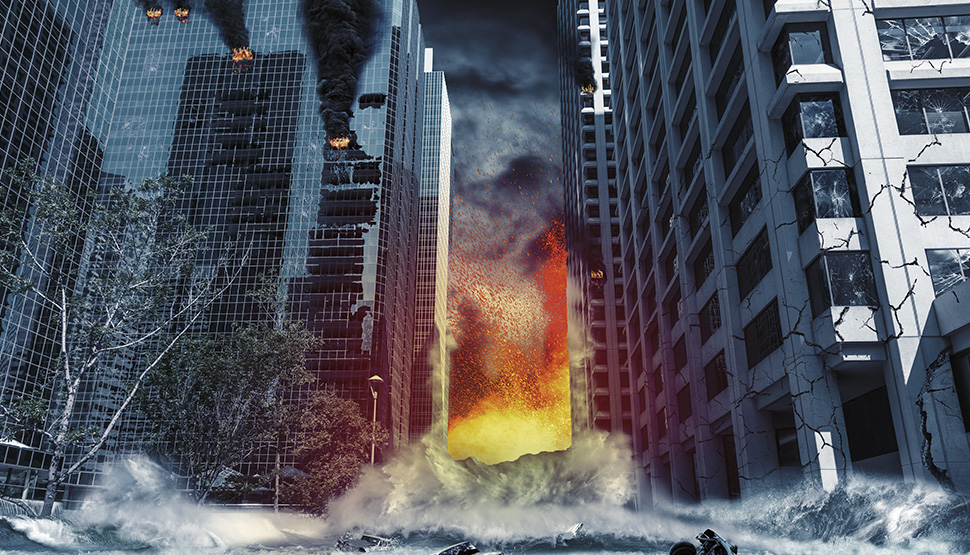Climate Change Is Threatening Your Company’s Building
Insurance won’t be enough to protect it

‘Insurance companies are more hesitant to offer large policies, rates are going up, and overall it’s getting tougher for companies to protect their risk via an insurance policy.’
As the impacts of climate change become more extreme and widespread, FM has a message for building owners: Insurance can’t save you.
From businesses located in flood zones to property at risk from wildfire or sea level rise, the physical infrastructure holding up many companies is increasingly vulnerable to extreme weather and events driven by the changing climate.
“Insurance companies are more hesitant to offer large [policies], rates are going up, overall it’s getting tougher and tougher for companies to protect their risk via an insurance policy,” says Louis Gritzo, vice president and manager of research at FM. “That’s what we’re seeing this year. I don’t expect it’s going to go away.” With climate risks on the rise, some insurers expect that insurance premiums to protect against them will soon be unaffordable to most people. A recent report from McKinsey suggests the property insurance industry will need to significantly evolve to deal with the impacts of climate change.
If businesses can’t insure their way to climate protection, Gritzo says, they’ll have to do it by design. That means integrating climate adaptation and resilience into the design of their buildings, from waterproofing to relocating essential equipment to installing wind-resistant roofing to scrapping a risky location and moving somewhere safer.
Inevitably, these efforts come with costs that some businesses are loath to take on. “The one that I’ve heard the most frequently is, ‘We just don’t know enough about the change in the climate, therefore we certainly wouldn’t want to spend money if we don’t have to on these things,'” Gritzo says. But this is outdated thinking, he argues. “We do know most of what we need to know about the big factors that are changing climate risk. It’s flood, rising sea level, increased rainfall rates. It’s increasing wildfire risks because of warming temperatures and extended droughts. We know enough about those trends.”
Gritzo says companies are starting to face the reality that the changing climate could lead to damages and business interruptions that go far beyond a broken pipe or power outage. “Climate risk has really made its way to risk managers’ priorities and I think that’s largely because it’s made its way to the boardroom, it’s made its way to shareholders, and privately held companies are thinking about it as well,” he says.
Companies that FM has advised have made changes to their facilities and buildings that have already proven their worth. For example, businesses in south Texas invested in measures that kept water out of areas with high-value equipment during Hurricane Harvey in 2017. And for a large European logistics company with more than 27,000 employees, redesigning warehouses to be both energy-efficient and safe during extreme weather led to lower electricity bills and a sense of security in the face of unanticipated climate events.
For some buildings, retrofits can add a level of resilience and prevent at least some damage. Essential infrastructure can be moved, roofs can be reinforced, even levees can be built around low-lying facilities in flood-prone areas. But Gritzo notes that these kinds of interventions may be hard to accomplish with older buildings or so costly to implement that it might make more sense to design and build an entirely new facility, maybe in a safer location. “The ideal scenario is to catch risk on the front end and integrate it into the design,” he says. Large-scale projects like the campus developed on Roosevelt Island in New York offer lessons on how to design with risks like sea level rise in mind.
Architects and companies should be working together to develop designs that do more than just meet immediate needs, but that also account for risks likely to increase in the coming years and decades. Gritzo says they have to resist the urge toward “short-termism” in their facility planning and design, investing up front in sustainability, resilience, and other climate adaptations to offset risks that insurance companies are unlikely to cover through standard policies.
“Businesses have to make that decision that they are indeed going to invest,” Gritzo says. “They’re not going to build something and move, a few years here, a few years there. They’re going to be more stable and invest in a quality building.”
Because if insurers aren’t going to be willing to carry the risk of an unsafe building in a climate-threatened place, the building will have to do more to protect itself.
Download a copy of the article
Republished with permission from Fast Company.
